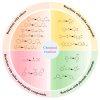Singlet Oxygen in Food: A Review on Its Formation, Oxidative Damages, Quenchers, and Applications in Preservation
- PMID: 40722969
- PMCID: PMC12292476
- DOI: 10.3390/antiox14070865
Singlet Oxygen in Food: A Review on Its Formation, Oxidative Damages, Quenchers, and Applications in Preservation
Abstract
Singlet oxygen (1O2) has been proven to simultaneously cause oxidative damage to food and the death of microorganisms. In order to enhance the utilization of 1O2 in food systems, this review presents an overview of recent studies on the formation mechanisms of 1O2, the damage mechanisms of 1O2 on food, the self-protective mechanisms in food against 1O2, and the applications of 1O2 in food preservation based on the narrative review guidelines. Studies have shown that in vegetable and meat systems, 1O2 is mainly produced through photochemical reactions. It has been suggested that proteins and lipids are the main target compounds for oxygen in food. Natural antioxidants in food (such as vitamin E and carotenoids) can remove 1O2 through physical or chemical quenching mechanisms. Novel preservation techniques featuring a thin film technology coupled with photosensitizers have been employed on the surface of food to prolong the shelf life. However, how to balance the bactericidal effect of 1O2 and its oxidative effects on food still requires further research. It could be feasible that 1O2 will play an increasingly important role in the future food industry on the premise of strengthening supervision over food safety risks induced by 1O2.
Keywords: food preservation; formation mechanisms; oxidative damages; quenching mechanisms; singlet oxygen.
Conflict of interest statement
The authors declare no conflicts of interest.
Figures
Similar articles
-
Management of urinary stones by experts in stone disease (ESD 2025).Arch Ital Urol Androl. 2025 Jun 30;97(2):14085. doi: 10.4081/aiua.2025.14085. Epub 2025 Jun 30. Arch Ital Urol Androl. 2025. PMID: 40583613 Review.
-
[Volume and health outcomes: evidence from systematic reviews and from evaluation of Italian hospital data].Epidemiol Prev. 2013 Mar-Jun;37(2-3 Suppl 2):1-100. Epidemiol Prev. 2013. PMID: 23851286 Italian.
-
Short-Term Memory Impairment.2024 Jun 8. In: StatPearls [Internet]. Treasure Island (FL): StatPearls Publishing; 2025 Jan–. 2024 Jun 8. In: StatPearls [Internet]. Treasure Island (FL): StatPearls Publishing; 2025 Jan–. PMID: 31424720 Free Books & Documents.
-
The Black Book of Psychotropic Dosing and Monitoring.Psychopharmacol Bull. 2024 Jul 8;54(3):8-59. Psychopharmacol Bull. 2024. PMID: 38993656 Free PMC article. Review.
-
The Subscapularis-Sparing Windowed Anterior Technique (SWAT) for Anatomic Total Shoulder Arthroplasty.JBJS Essent Surg Tech. 2025 Jul 17;15(3):e24.00007. doi: 10.2106/JBJS.ST.24.00007. eCollection 2025 Jul-Sep. JBJS Essent Surg Tech. 2025. PMID: 40678180 Free PMC article.
References
-
- Unsihuay D., Su P., Hu H., Qiu J., Kuang S., Li Y., Sun X., Dey S.K., Laskin J. Inside Cover: Imaging and Analysis of Isomeric Unsaturated Lipids through Online Photochemical Derivatization of Carbon–Carbon Double Bonds (Angew. Chem. Int. Ed. 14/2021) Angew. Chem. Int. Ed. 2021;60:7450. doi: 10.1002/anie.202102052. - DOI - PMC - PubMed
-
- do Prado-Silva L., Brancini G.T.P., Braga G.Ú.L., Liao X., Ding T., Sant’Ana A.S. Antimicrobial Photodynamic Treatment (APDT) as an Innovative Technology to Control Spoilage and Pathogenic Microorganisms in Agri-Food Products: An Updated Review. Food Control. 2022;132:108527. doi: 10.1016/j.foodcont.2021.108527. - DOI
Publication types
Grants and funding
- 2023J01480/Fujian Provincial Department of Science and Technology
- NERD202231/National Engineering Research Center of Sugarcane
- N2023T029/Nanping City Department of Science and Technology
- FJJKBK23-210/2023 Annual Education Science Project for "14th Five-Year Plan" of Fujian Province
- 2022L3086/Special Project for the Central-guided Local Science and Technology Development
LinkOut - more resources
Full Text Sources





